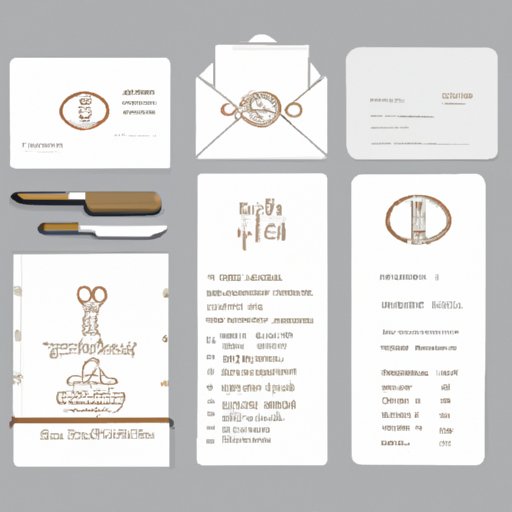Introduction
When it comes to planning a wedding, one of the most important tasks is sending out the wedding invitations. Addressing wedding invitations correctly can be a daunting task, especially if you are not sure how to go about it. This article will provide you with a comprehensive guide on how to address wedding invitations the right way.

Create a Guide to Addressing Wedding Invitations
The first step in addressing wedding invitations is to create a guide. This guide should include all the necessary information for each type of invitation recipient, such as their full name, title, and address. It is also helpful to include any special instructions or notes that may be needed. Once you have created your guide, it is time to start addressing the envelopes.
Examples of Properly Addressed Wedding Invitations
When it comes to addressing wedding invitations, there are certain rules that must be followed. Here are some examples of properly addressed wedding invitations:
- Mr. and Mrs. John Smith
- Dr. and Mrs. John Smith
- The Honorable John Smith and Dr. Sarah Smith
- Mr. and Mrs. John Smith and Family
- Ms. Sarah Smith and Mr. John Smith

Tips for Properly Addressing Wedding Invitations
When addressing wedding invitations, it is important to follow certain guidelines. Here are some tips for properly addressing wedding invitations:
Tips for Writing Names on the Envelope
- Always write out the full name of each guest.
- For married couples, list both names on the same line.
- If the couple is divorced, list each name on separate lines.
- If the couple has different last names, list the name of the person you are inviting first.
Tips for Writing Out Titles and Abbreviations
- When writing out titles and abbreviations, always use the full name (i.e. Doctor, Professor, etc.).
- Do not use abbreviations for titles when sending out formal invitations.
- When sending out informal invitations, you can use abbreviations for titles (i.e. Dr., Prof., etc.).
Tips for Handling Special Cases
- For same sex couples, list both names on the same line.
- For unmarried couples living together, list both names on the same line.
- For divorced couples, list both names on separate lines.
- For blended families, list the children’s names on separate lines.

How to Address Wedding Invitations the Right Way
Once you have created your guide and have written out all the names and addresses, it is time to start addressing the envelopes. There are several different types of addressing styles, so it is important to understand the differences between them before you begin.
Understanding Different Types of Addressing
- Formal – This is the most traditional style of addressing wedding invitations. When using this style, titles and surnames are used when addressing the envelopes.
- Informal – This style of addressing is more casual than the formal style. Titles and surnames are still used, but they are not required.
- Semi-Formal – This style is a combination of the formal and informal styles. Titles and surnames are used, but they are not required.
Guidelines for Addressing Different Types of Guests
- For family members, use the full name of each person.
- For close friends, use the first name and surname of each person.
- For co-workers, use the title and surname of each person.
A Comprehensive Guide to Addressing Wedding Invitations
Now that you have an understanding of the different types of addressing styles, it is time to learn how to address wedding invitations the right way. Here is a comprehensive guide to help you get started:
Understanding Different Salutations
- Formal – This salutation is typically used for more formal invitations. Examples include “Mr. and Mrs. John Smith” or “The Honorable John Smith and Dr. Sarah Smith”.
- Informal – This salutation is typically used for more casual invitations. Examples include “John and Sarah” or “John and Sarah Smith”.
- Semi-Formal – This salutation is a combination of the formal and informal salutations. Examples include “Mr. and Mrs. John Smith and Family” or “Ms. Sarah Smith and Mr. John Smith”.
Guidelines for Using Different Salutations
- For married couples, use the formal or semi-formal salutation.
- For unmarried couples, use the informal salutation.
- For divorced couples, use the semi-formal salutation.
- For same sex couples, use the informal salutation.
- For blended families, use the semi-formal salutation.
The Dos and Don’ts of Addressing Wedding Invitations
When addressing wedding invitations, there are certain dos and don’ts that you should keep in mind. Here are some of the dos and don’ts of addressing wedding invitations:
Dos
- Do make sure to use the correct salutation for each type of guest.
- Do double check all addresses before sending out the invitations.
- Do include any special instructions or notes that may be needed.
Don’ts
- Don’t forget to include titles and surnames when addressing formal invitations.
- Don’t use abbreviations for titles when addressing formal invitations.
- Don’t forget to include any special instructions or notes that may be needed.
Conclusion
Addressing wedding invitations correctly is an important part of the wedding planning process. By following the steps outlined in this article, you can ensure that your wedding invitations are addressed the right way. Remember to use the correct salutation for each type of guest, double check all addresses before sending out the invitations, and include any special instructions or notes that may be needed.


